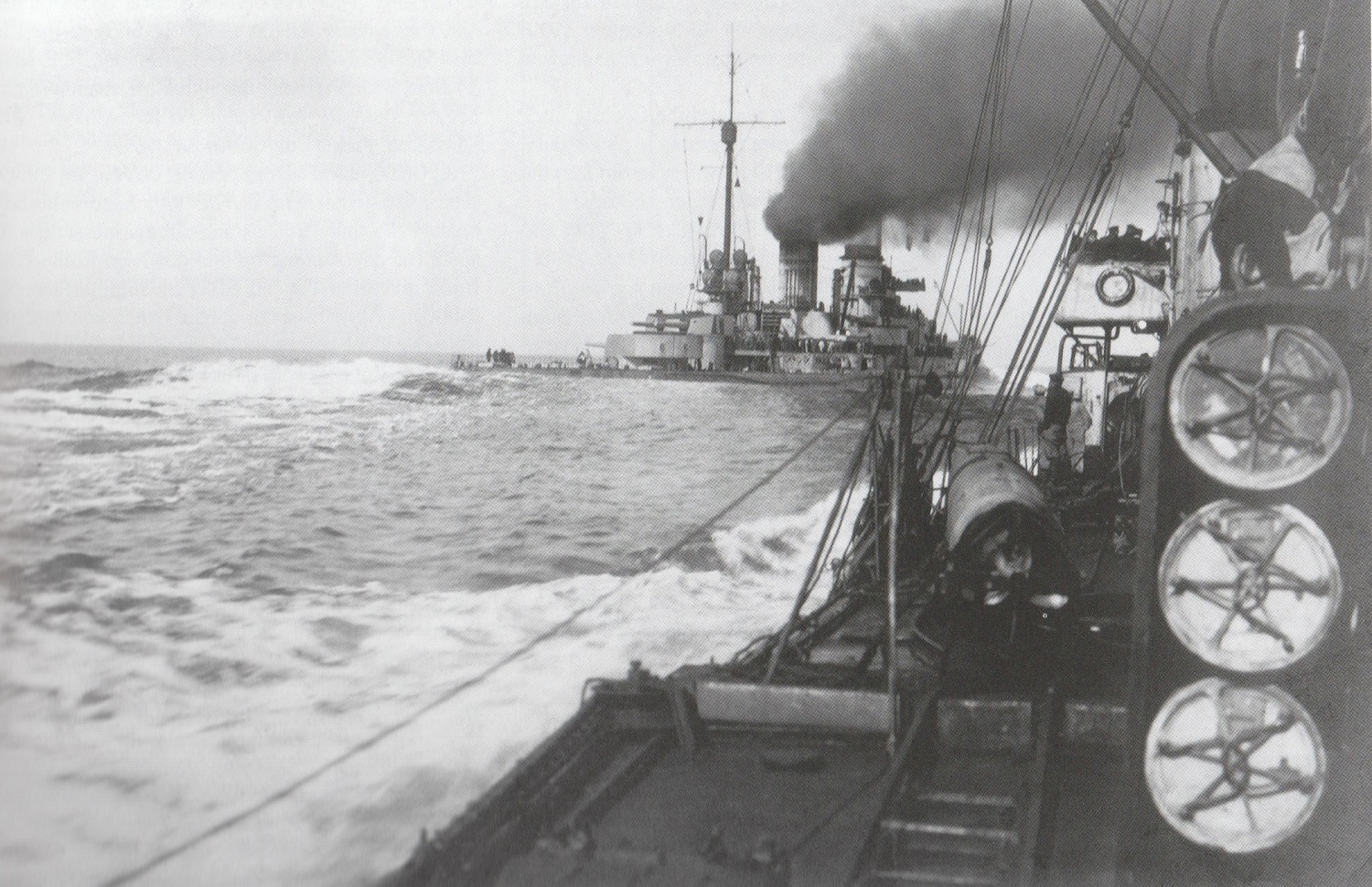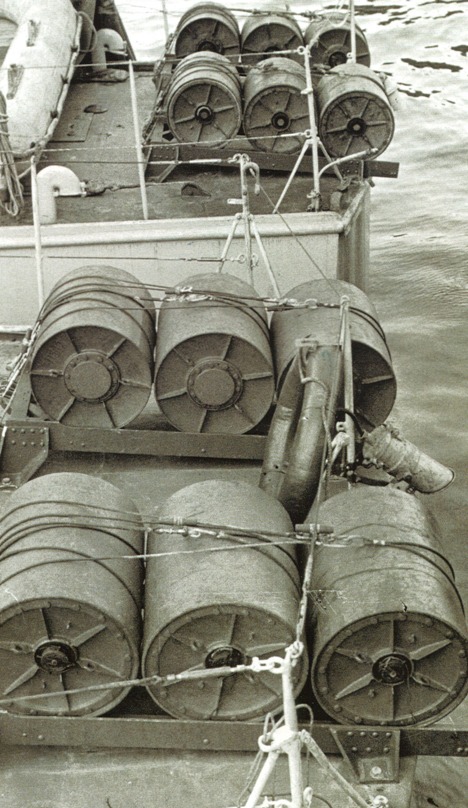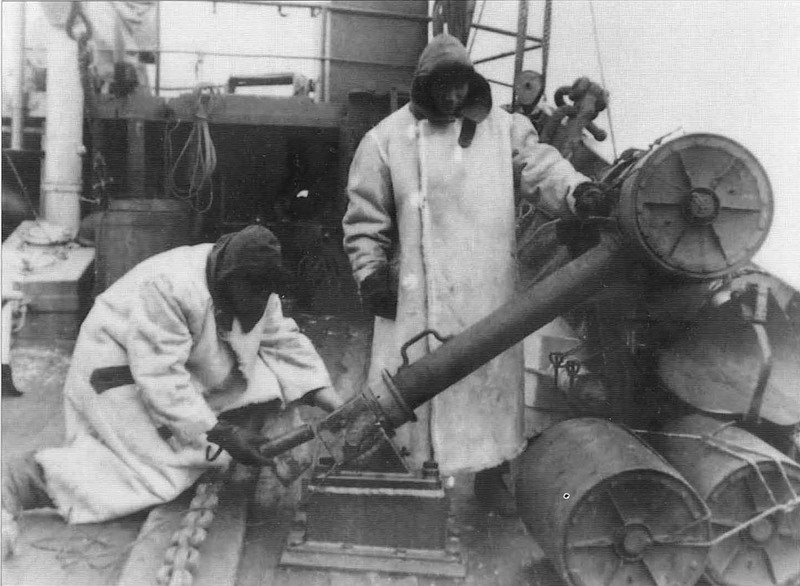The "Wasserbombe" (WB) or Depth Charge remained the principal anti-submarine weapon in both World Wars. Aircraft generally used standard depth charges, but strengthened "Flugzeuge Wasserbomben" (Aircraft Depth Charges) specifically made for aircraft were in service.
Only one non-Soviet submarine was possibly sunk by aircraft (HMS Narwhal) and another was shared with surface ships (HMS Shark). One British submarine was forced to surrender (HMS Seal) after hitting a mine and then being attacked by aircraft. At least these last two and possibly all three submarines were damaged by bombs, not depth charges. Three additional British submarines were bombed by German planes while docked at Malta.
Surface ships accounted for twelve non-Soviet submarines in addition to the one shared with aircraft. Information on Soviet submarine losses are unreliable even now, but, omitting harbor or stranded losses, it appears that about five were sunk by aircraft and about 18 by surface vessels.
World War II DC had six depth settings for each type, running from 49-82 feet (15-25 m) up to the maximum depths listed below. The depth was controlled by a time fuze. No magnetic (influence) or other triggers were ever developed. The maximum destructive radius against a 0.5" (12 mm) hull were 26 feet (8 m) for the WBD and 18 feet (5.6 m) for the others.
There were several ASW weapons under development in 1945, including long-range mortars and rockets, but none appear to have seen service.
Post-war, Germany has used USA and other NATO ASW munitions.
"Blind Time" is the time between when a weapon is launched and when it reaches the target location. In addition, most early sonar systems lost the target submarine on close approach, usually requiring a "sprint" to reduce blind time. For depth charges, this meant that they were dropped or fired after the sonar contact was lost.
World War I torpedo boats and destroyers carried six charges while ASW trawlers and net tenders carried four.
World War II destroyers were designed with four DC throwers abreast the after superstructure and two racks on the port and starboard quarters. Up until 1939, only 18 DCs were carried, with six of these being in the racks. These numbers were increased once the war started. For example, on her surrender in 1945, Z33 carried thirty lightweight DC with four throwers.
| Date Of Design | 1914 |
|---|---|
| Date In Service | 1915 |
| Total Weight | 200 lbs. (91 kg) |
| Explosive Charge | 110 lbs. (50 kg) |
| Sink Rate / Terminal Velocity | N/A |
| Settings | N/A |
The only depth charge used by the Germans during World War I. Produced by Carbonit Gesellschaft, this used a float with a lanyard and a back up timer device. This DC worked only about 50% of the time, and the Navy considered it to be too heavy for the charge weight. It was also faulted for having too slow a sink rate and being difficult to manufacture. Only 2,256 were produced during the War. According to a British document, this DC was a cylinder about 4 ft. long by 1 ft. in diameter (120 cm x 30 cm) with the float painted black and the explosive section painted red. However, from a sketch in this document, I believe that the British mis-identified the two sections and the colors are therefore reversed. Some WBA C/15 were supplied to Austria-Hungary who considered them too heavy and developed their own, lighter depth charge.
A Note on Sources: "German Battlecruisers of World War One" identifies the Torpedo Boat in the adjacent photograph as V8. However, there was no German ship by that designation during World War I. Possibly the TB was V6.
| Date Of Design | 1924 |
|---|---|
| Date In Service | 1925 |
| Total Weight | about 441 lbs. (200 kg) |
| Explosive Charge | 291 lbs. (132 kg) |
| Sink Rate / Terminal Velocity | N/A |
| Settings | N/A |
Used a hydrostatic fuze.
| Date Of Design | N/A |
|---|---|
| Date In Service | N/A |
| Total Weight | 397 lbs. (180 kg) |
| Explosive Charge | 276 lbs. (125 kg) SW18 |
| Sink Rate / Terminal Velocity | 11.5 fps (3.5 mps) |
| Settings | 394 feet (120 m) max |
Developed prior to World War II.
| Date Of Design | N/A |
|---|---|
| Date In Service | N/A |
| Total Weight | 353 lbs. (160 kg) |
| Explosive Charge | 220 lbs. (100 kg) SW18 |
| Sink Rate / Terminal Velocity | 10.0 fps (3.0 mps) |
| Settings | 394 feet (120 m) max |
This DC may also have been known as WBD II.
| Date Of Design | N/A |
|---|---|
| Date In Service | N/A |
| Total Weight | 306 lbs. (139 kg) |
| Explosive Charge | 132 lbs. (60 kg) SW18 |
| Sink Rate / Terminal Velocity | 7.3 fps (2.23 mps) |
| Settings | 246 feet (75 m) max |
| Date Of Design | N/A |
|---|---|
| Date In Service | N/A |
| Total Weight | 397 lbs. (180 kg) |
| Explosive Charge | 132 lbs. (60 kg) SW18 |
| Sink Rate / Terminal Velocity | 11.5 fps (2.35 mps) |
| Settings | 394 feet (120 m) max |
| Date Of Design | N/A |
|---|---|
| Date In Service | N/A |
| Total Weight | 529 lbs. (240 kg) |
| Explosive Charge | 132 lbs. (60 kg) SW18 |
| Sink Rate / Terminal Velocity | 14.3 fps (4.35 mps) |
| Settings | 492 feet (150 m) max |
Designations are not available at this time. It would appear that stern racks held three DC and that smaller vessels had several single DC holders arranged along the sides of the after superstructure.
Most were single DC throwers, similar to Allied versions. A Rheinmetall drawing shows a weight of 606 lbs. (275 kg), initial velocity of 115 fps (35 mps) and an arbor weight of 77 lbs. (35 kg).
Two explosive sweeps were developed during World War I. The first, "Sprenganker" (explosive anchor), was a grapple on the end of a wire cable. This used a sea kite to maintain drift and was towed by two drifters 50 meters apart (55 yards). When the grapple caught a submarine, it pulled a charge off the deck of one of the drifters and guided it to the submarine. The fuze was timed by the depth of the grapple.
The second sweep, "U-Bootsdrachen (UD)" (U-boat kite), designated as UD15 - meaning that it was developed in 1915 - was a 200 kg (441 lbs.) charge towed at depths down to 25 meters (80 feet) on a 100 meter (110 yards) cable. Depth was maintained by a sea kite and could be towed at speeds between 6 and 21 knots. The charge exploded automatically by an electrical current passed down the cable when it struck a submarine. The Russian submarine Barr was sunk on 21 May 1917 by a UD15.
"Naval Weapons of World War Two" by John Campbell
"S-Boote: German E-boats in action 1939 - 1945" by Jean-Philippe Dallies-Labourdette
"Find and Destroy: Antisubmarine Warfare in World War I" by Dwight R. Messimer
"Naval Weapons of World War One," "US Naval Weapons" and "The Naval Institute Guide to World Naval Weapon Systems 1991/92" all by Norman Friedman
"German Battlecruisers of World War One" by Gary Staff
"German Destroyers of World War Two (Second Edition)" by M.J. Whitley
---
"German Navy: Naval Guns, Mountings, Sights and Table of Ordnance, July 1917" by (U.S.) Navy Department, Office of Naval Intelligence. Reprint of British Admiralty Publication.
BAMA RM7-2379
23 May 2006 - Benchmark
07 January 2012 - Added picture of WBG Depth Charges
30 December 2017 - Converted to HTML 5 format, minor correction
11 February 2023 - Added information on WBA C/15, WB DM II, LWB II, aircraft successes, sweeps and photographs of Torpedo Boat V6 and depth charge projector



